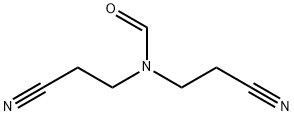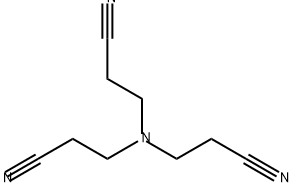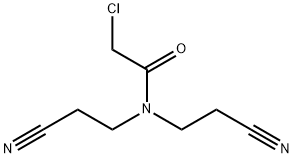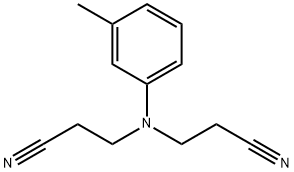A5092712
3,3'-Iminodipropionitrile , >90.0%(GC) , 111-94-4
Synonym(s):
Bis(2-cyanoethyl)amine
CAS NO.:111-94-4
Empirical Formula: C6H9N3
Molecular Weight: 123.16
MDL number: MFCD00001956
EINECS: 203-922-3
Update time: 2022-07-08
PRODUCT Properties
| Melting point: | -6 °C |
| Boiling point: | 205 °C25 mm Hg(lit.) |
| Density | 1.02 g/mL at 25 °C(lit.) |
| refractive index | n |
| Flash point: | >230 °F |
| storage temp. | 2-8°C |
| form | clear liquid |
| pka | 6.13±0.19(Predicted) |
| color | Colorless to Light yellow to Light orange |
| Water Solubility | Soluble in water. |
| Stability: | Stable, but moisture sensitive. Reaction with moisture may lead to a build up of pressure in sealed bottles. Combustible. Incompatible with strong oxidizing agents. |
| CAS DataBase Reference | 111-94-4(CAS DataBase Reference) |
| EPA Substance Registry System | 3,3'-Iminobispropanenitrile (111-94-4) |
Description and Uses
Bis(2-cyanoethyl)amine is used as pharmaceutical intermediates.
Safety
| Symbol(GHS) |    GHS07,GHS05,GHS06 |
| Signal word | Warning |
| Hazard statements | H315-H319-H301-H318-H335 |
| Precautionary statements | P261-P280a-P301+P310a-P305+P351+P338-P405-P501a-P264-P280-P302+P352+P332+P313+P362+P364-P305+P351+P338+P337+P313 |
| Hazard Codes | Xi |
| Risk Statements | 36/37/38 |
| Safety Statements | 26 |
| RIDADR | UN 3334 |
| WGK Germany | 2 |
| RTECS | UG2975000 |
| TSCA | Yes |
| HS Code | 29269095 |
| Hazardous Substances Data | 111-94-4(Hazardous Substances Data) |
| Toxicity | A neurotoxic synthetic nitrile that causes proximal axonopathies in the spinal cord and brain stem. The proximal axonal swellings are due to interruption of slow axonal transport, resulting in a large accumulation of neurofilaments. Secondary to these effects is a progressive atrophy of the distal axon, secondary demyelination, and gliosis. The slow axonal transport defect appears to be selective, as little evidence for perturbations in fast axonal transport have been reported. Behaviorally, IDPN induces hyperactivity, a “waltzing syndrome,” circling and head-rolling in mice and rats. IDPN intoxication has been advanced as a model for certain motor neuron degenerative diseases such as amyotropic lateral sclerosis (ALS) and hereditary canine spinal muscular atrophy (HCSMA). |






